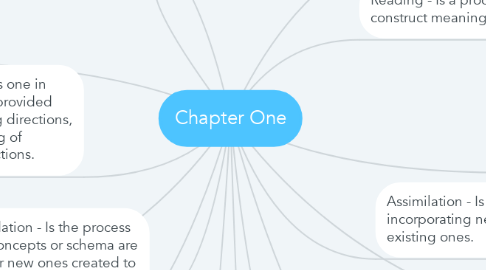Chapter One
by Emma Brennan

1. Scripted Programs - Is one in which the teacher is provided with specific teaching directions, including the wording of directions and instructions.
2. Cognitivism - Is a philosophy of learning that describes the activities of an organism in terms of observable actions or behaviors and internal or mental states.
3. Constructionism - Is a cognitive philosophy of learning that describes learning as an active process in which the learner constructs mental models of reality.
4. Accommodation - Is the process by which concepts or schema are modified or new ones created to accommodate new knowledge.
5. Zone of Proximal Development (ZPD) - Is the area between independent performance and potential as determined through problem solving under guidance of an adult or more capable peer.
6. Scaffolding - Refers to the support and guidance provided by an adult that helps a student function on a higher level.
7. Bottom-up approach - Refers to a kind of processing in which meaning is derived from the accurate, sequential processing of words. The emphasis is on the text rather than the reader’s background knowledge or language ability.
8. Effect size - Is the degree to which the experimental group did better than a matched group of students on achievement or some other outcome. Effect sizes are typically expressed in standard deviations. Average effect size is .4. An effect size of .2 is small, and one of .8 is high.
9. Reading - Is a process in which we construct meaning from print.
10. Behaviorism - Is a philosophy of learning that describes all the activities of an organism in terms of observable actions or behaviors.
11. Assimilation - Is the process of incorporating new ideas into existing ones.
12. Holistic - Refers to the practice of learning through the completion of whole tasks rather than fragmented subskills and fragments of reading and writing.
13. Top-down approach - Refers to deriving meaning by using one’s background knowledge, language ability, and expectations. The emphasis is on the reader rather than the text.
14. Transaction - Refers to the relationship between the reader and the text in which text is conditioned by the reader and the reader is conditioned by the text.
15. Standard deviation - Is a measure of variance or how much there is on average. A low standard deviation means there is little variance. Scores cluster around the mean or average. A high standard deviation means that there is a wide variance. Scores are more widely dispersed.
16. Percentile rank - Is the point on a scale of 1 to 99 that shows what percentage of students obtained an equal or lower score. A percentile rank fi 75 means that the person scored higher than 75 percent of those who took the test.


